
The Bay of Fundy is a bay between the Canadian provinces of New Brunswick and Nova Scotia, with a small portion touching the U.S. state of Maine. It is an arm of the Gulf of Maine. Its tidal range is the highest in the world. The name is probably a corruption of the French word fendu, meaning 'split'.
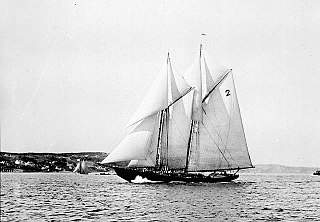
Bluenose was a fishing and racing gaff rig schooner built in 1921 in Lunenburg, Nova Scotia, Canada. A celebrated racing ship and fishing vessel, Bluenose under the command of Angus Walters, became a provincial icon for Nova Scotia and an important Canadian symbol in the 1930s, serving as a working vessel until she was wrecked in 1946. Nicknamed the "Queen of the North Atlantic", she was later commemorated by a replica, Bluenose II, built in 1963. The name Bluenose originated as a nickname for Nova Scotians from as early as the late 18th century.

On the morning of 6 December 1917, the French cargo ship SS Mont-Blanc collided with the Norwegian vessel SS Imo in the waters of Halifax, Nova Scotia, Canada. The Mont-Blanc, laden with high explosives, caught fire and exploded, devastating the Richmond district of Halifax. At least 1,782 people were killed, largely in Halifax and Dartmouth, by the blast, debris, fires, or collapsed buildings, and an estimated 9,000 others were injured. The blast was the largest human-made explosion at the time. It released the equivalent energy of roughly 2.9 kilotons of TNT (12 TJ).
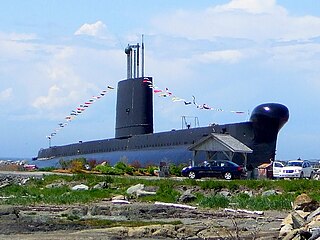
HMCS Onondaga (S73) is an Oberon-class submarine that served in the Royal Canadian Navy and later the Canadian Forces. Built in the mid-1960s, Onondaga operated primarily with the Maritime Forces Atlantic until her decommissioning in 2000 as the last Canadian Oberon.

HMCS Sackville is a Flower-class corvette that served in the Royal Canadian Navy and later served as a civilian research vessel. She is now a museum ship located in Halifax, Nova Scotia, and the last surviving Flower-class corvette.

SS Atlantic was a transatlantic ocean liner of the White Star Line, and second ship of the Oceanic-class. The ship operated between Liverpool, United Kingdom, and New York City, United States. During the ship's 19th voyage, on 1 April 1873, she struck rocks and sank off the coast of Nova Scotia, Canada, killing at least 535 people. It remained the deadliest civilian maritime disaster in the North Atlantic Ocean until the sinking of SS La Bourgogne on 2 July 1898 and the greatest disaster for the White Star Line prior to the loss of Titanic in April 1912.

MV Joseph and Clara Smallwood was a Marine Atlantic passenger/vehicle ferry which operated between Newfoundland and Cape Breton Island in eastern Canada. She is named after former Newfoundland premier Joseph R. Smallwood and his wife Clara.

Theodore Tugboat is a Canadian children's television series about a tugboat named Theodore who lives in the Big Harbour with all of his friends. The show originated in Halifax, Nova Scotia, Canada as a co-production between the CBC, and the now defunct Cochran Entertainment, and was filmed on a model set using radio controlled tugboats, ships, and machinery. Production of the show ended in 2001, and its distribution rights were later sold to Classic Media. The show premiered in Canada on CBC Television, then went to PBS, was on Qubo in the United States, and has appeared in eighty different countries.
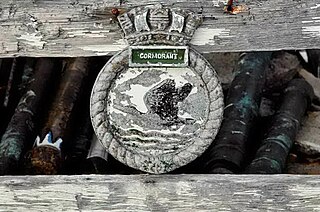
HMCS Cormorant was a diving support vessel that served in the Canadian Forces. She was equipped with two SDL-1 submersibles. The ship was the first in the Canadian Forces to have women assigned to their crew. Initially constructed as the trawler Aspa Quarto in 1965, the ship was acquired by the Canadian Forces in 1975 and renamed Cormorant. The vessel remained in service until 1997 when Cormorant was sold to a US buyer. The ship was laid up at Bridgewater, Nova Scotia in 2000 and was removed on 18 November 2020 to be scrapped in Sheet Harbour.
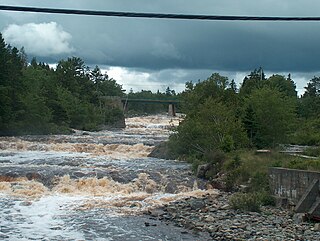
Sheet Harbour is a rural community in Nova Scotia, Canada. It is located in the eastern reaches of the Halifax Regional Municipality, approximately 117 km (73 mi) northeast of the central urban area of the municipality, concentrated on Downtown Halifax and Dartmouth. The community is located along the Marine Drive scenic route on Trunk 7 at its junctions with Route 224 and Route 374. Surrounding the branched harbour which its name is derived from, the community has a population of about 800 and its respective census tract, containing sizable amounts of land around the community, has a population of 3,478 as of the 2011 Census. Two rivers, West River and East River, flow through the community and into the Northwest and Northeast Arms of the harbour respectively. The coastline of the community is heavily eroded and the region in which the community is located has an abundance of lakes. The region has a humid continental climate, congruent with the majority of Nova Scotia, and the ocean significantly influences the temperature.

Baron of Renfrew was a four-masted barque of 5,294 gross register tonnage (GRT), built of wood in 1825 by Charles Wood in Quebec, Canada. She was one of the largest wooden ships ever built, although she was a disposable ship built for a one-way voyage to transport timber to England and did not complete a single voyage before breaking up.

CCGS Tupper was a Canadian Coast Guard ice-strengthened buoy tender that served from 1959 to 1998. The vessel spent her entire career on the East Coast of Canada. Following her Canadian service, Tupper was sold to private interests with the intention of converting her to a yacht, but the conversion never happened and the vessel moved about Halifax Harbour, suffering a fire in 2008 before being sold for scrap in 2011. The vessel was not scrapped and the Canadian Coast Guard was forced to address the pollution concerns of the abandoned vessel in 2021.
Kings County was a four-masted barque built in 1890 at Kingsport, Nova Scotia on the Minas Basin. She was named to commemorate Kings County, Nova Scotia and represented the peak of the county's shipbuilding era. Kings County was one of the largest wooden sailing vessels ever built in Canada and one of only two Canadian four-masted barques. At first registered as a four-masted full-rigged ship, she was quickly changed to a barque after her June 2 launch. More than three thousand people from Kings and Hants counties attended the launch. She survived a collision with an iceberg on an 1893 voyage to Swansea, Wales. Like many of the large wooden merchant ships built in Atlantic Canada, she spent most of her career far from home on trading voyages around the world. In 1909, she returned to the Minas Basin for a refit at Hantsport and loaded a large cargo of lumber. In 1911 she became the largest wooden ship to enter Havana Harbour when she delivered a cargo of lumber and was briefly stranded. She was lost a few months later on a voyage to Montevideo, Uruguay when she ran aground in the River Plate. Too damaged to repair, she was scrapped in Montevideo where her massive timbers were visible for many years.
Hamburg was a three masted barque built in 1886 at Hantsport, Nova Scotia. She was the largest three masted barque ever built in Canada.

SSMont-Blanc was a cargo steamship that was built in Middlesbrough, England in 1899 for a French shipping company. On Thursday morning, December 6, 1917, she entered Halifax Harbour in Nova Scotia, Canada laden with a full cargo of highly volatile explosives. As she made her way through the Narrows towards Bedford Basin, she was involved in a collision with Imo, a Norwegian ship. A fire aboard the French ship ignited her cargo of wet and dry 2,300 tons of picric acid, 500 tons of TNT, and 10 tons of guncotton. The resultant Halifax Explosion levelled the Richmond District and killed approximately 2,000 people, and the injured may have been about 9,000.

SS Imo was a merchant steamship that was built in 1889 to carry livestock and passengers, and converted in 1912 into a whaling factory ship. She was built as Runic, renamed Tampican in 1895, Imo in 1912 and Guvernøren in 1920.

MV Canadian Miner was a Canadian laker that was part of the fleet of Upper Lakes Shipping from 1994–2011. Initially constructed as Maplecliffe Hall in 1966, the ship was renamed Lemoyne in 1988 before becoming Canadian Miner in 1994. In 2011, the name was shortened to just Miner. In 2011 the vessel was taken out of service and sold for scrapping. While en route to the scrapyard in Turkey, the ship ran aground off Nova Scotia in 2011. The vessel was broken up in 2014 in Nova Scotia.

West River Sheet Harbour is a river on the Eastern Shore of Nova Scotia, Canada, in the Halifax Regional Municipality. Its headwaters are near the Musquodoboit Valley and the river flows southeast and empties in to the Northwest Arm of Sheet Harbour, Nova Scotia. The river has three main tributaries: West River Main, Killag River and Little River. The river was suffering from acidification, so a lime doser was installed and has been in use since September 2005. It stabilized the river's pH at 5.5, a healthy level for aquatic life.
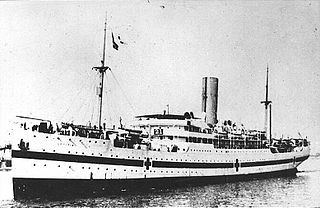
HMHS Letitia was a British hospital ship that ran aground at Portuguese Cove in Halifax Harbour, Canada on 1 August 1917 while carrying 546 wounded Canadian soldiers from Liverpool, United Kingdom to Halifax, Nova Scotia, Canada.
MV Salvador Allende was a cargo ship that sank in December 1994 in the North Atlantic Ocean with the loss of 29 of her 31 crew members.
















